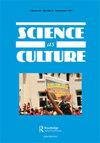重新想象太空时代:从地球实地工作实践的早期卫星发展
IF 2.5
3区 哲学
Q1 CULTURAL STUDIES
引用次数: 1
摘要
摘要太空技术的想象受到了火箭、发射器、太空探索和载人航天领域(通常以美国为中心)转折点的影响:主要是在冷战竞争、军事和声望目标中嵌入的技术官僚大科学产品方面。虽然这种表述有助于理解空间时代的许多发展,但它往往淡化了数据收集和解释的自然历史实践在空间技术发展中的作用。社会技术想象的概念有助于揭示对空间技术历史的更复杂和完整的理解。1967年至1973年间,法国遥感卫星的愿景,既是由飞机照片判读促成的,也是飞机照片判读的延伸,有助于形成对遥感技术的科学和技术期望。反过来,飞机照片口译员的实践、价值观和愿景为卫星遥感工作的发展提供了信息。特别是,以实地调查为主导的研究模式,侧重于数据收集和实地观测,是卫星技术发展的重要组成部分,这种联系至今仍很牢固。通过历史研究来研究遥感卫星技术,不仅提出了一种在实地科学实践、话语和历史传统中想象空间技术的特殊方式,而且使我们能够反思普遍想象的力量和局限性,以充分理解太空时代及其在历史中的地位。本文章由计算机程序翻译,如有差异,请以英文原文为准。
Re-imagining The Space Age: Early Satellite Development from Earthly Fieldwork Practice
ABSTRACT Imagining space technology has been influenced by (usually American-centred) turning points in rocketry, launchers, space exploration and human spaceflight: principally in terms of techno-bureaucratic Big Science products embedded in Cold War rivalry, military and prestige objectives. While this representation is useful to understand many developments of the space age, it has tended to downplay the role of natural history practices of data collection and interpretation in the development of space technology. The notion of sociotechnical imaginary helps to reveal a more complex and complete understanding of the history of space technology. Between 1967 and 1973, the vision of the French remote-sensing satellite as both enabled by and an extension of aircraft photo-interpretation helped to shape scientific and technological expectations of remote-sensing technology. In turn, the practices, values, and visions of aircraft photo-interpreters informed the development of satellite remote-sensing work. In particular, the fieldwork-driven research mode, focusing on data collection and field observations, was an important part of satellite technology development –a tie which remains strong today. Approaching remote-sensing satellite technology through historical research not only suggests a particular way of imagining space technology within the tradition of field science practices, discourses, and history, but also allows us to reflect on the power and limitations of prevalent imaginaries to fully understand the space age and its place in history.
求助全文
通过发布文献求助,成功后即可免费获取论文全文。
去求助
来源期刊

Science As Culture
Multiple-
CiteScore
5.20
自引率
3.80%
发文量
28
期刊介绍:
Our culture is a scientific one, defining what is natural and what is rational. Its values can be seen in what are sought out as facts and made as artefacts, what are designed as processes and products, and what are forged as weapons and filmed as wonders. In our daily experience, power is exercised through expertise, e.g. in science, technology and medicine. Science as Culture explores how all these shape the values which contend for influence over the wider society. Science mediates our cultural experience. It increasingly defines what it is to be a person, through genetics, medicine and information technology. Its values get embodied and naturalized in concepts, techniques, research priorities, gadgets and advertising. Many films, artworks and novels express popular concerns about these developments. In a society where icons of progress are drawn from science, technology and medicine, they are either celebrated or demonised. Often their progress is feared as ’unnatural’, while their critics are labelled ’irrational’. Public concerns are rebuffed by ostensibly value-neutral experts and positivist polemics. Yet the culture of science is open to study like any other culture. Cultural studies analyses the role of expertise throughout society. Many journals address the history, philosophy and social studies of science, its popularisation, and the public understanding of society.
 求助内容:
求助内容: 应助结果提醒方式:
应助结果提醒方式:


